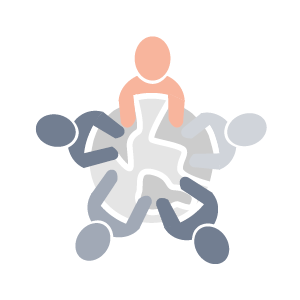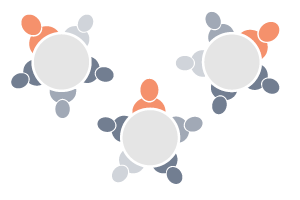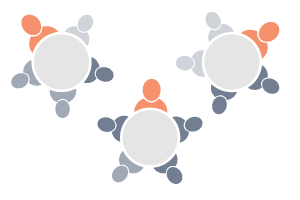
The World Café method allows workshop participants to explore an issue from different points of view, and to actively participate in small-group dialogue. It also serves to help participants learn more about a complex topic by gathering information in stages, as they engage with different stakeholders and/or sub-topics.
OVERVIEW
The participants engage in multiple rounds of small-group discussions, each facilitated at a different table. A host remains at each table, to start the discussion around a particular question, or a list of questions. As they move between tables, the participants learn more about the topic, but they also have the opportunity to actively share their thoughts with a variety of smaller groups.
WORKSHOP PHASE
NUMBER OF PARTICIPANTS
Minimum 15 participants
For larger groups, more stations can be created, or the number of participant per station can be increased.
TIME |
MODE OF DELIVERY
Minimum 60 minutes | F2F
TOOLS/MATERIALS
- A list of questions, visually displayed at the front of the room (see below).
- A number of tables (depending on the number of hosts and size of the group).
- Per table: Enough chairs, a large sheet of paper (or multiple papers, so that each participant at the table can comfortably reach it and add notes/doodles) and markers or pens – preferably in various colours.
PREPARATION
- The facilitators should first determine the topic of the exercise and the questions participants will need to explore. (Each station will be assigned a question/ set of questions). Note: The participants should familiar with the topic. They should have enough prior knowledge or experience of the issue to be able to actively participate in a discussion about it.
- A “host” should be identified for each table. The hosts should be informed in advance that they will remain at their allocated table, that they will welcome participants the participants for each round, introduce the question(s), and briefly summarise the previous round’s discussion.
- Each table should be set with enough chairs, a large sheet of paper and markers or pens – preferably in various colours.
- At the front of the room, the facilitator can set up a flipchart or project a screen, where the questions can be displayed.

Step 1
The facilitator starts the exercise by providing a short overview of the World Café method. They should emphasise that the objective of the exercise will be to instigate new ideas and thinking around a topic, to gain exposure to different viewpoints, and not necessarily to identify a single ‘right’ answer.

Step 2
The participants are asked to take a seat at the different tables. Before the exercise starts, they should be reminded of the time limit for each round of discussions, they should be informed of the role of the hosts, and they should be encouraged to make use of the writing materials to capture their ideas.

Step 3
The first round of conversation starts. At the end the round, all participants (except the hosts) are prompted to move to another table. They should spread out across the room, so that a new group forms each time (i.e. so that the participants have the opportunity to engage with a different mix of people during each round).

Step 4
The new round starts by each host summarising the insights from the previous conversation with the new group. This will allow the new group to build on (or productively challenge) the previous session’s ideas, rather than repeating them.

Step 5
When the final round is concluded, the facilitator asks the entire group to reflect on their experience of the exercise. Participants can first do this individually, by taking a moment to think about / jot down what they have learned. Then, either volunteers or the hosts can share a few key ideas/points of feedback on each of the questions. The facilitator can capture these points on the flipchart/screen at the front of the room.
Finally, the facilitator may conclude the World Café by suggesting a way forward. They could commit to circulating a shared document with each hosts’ notes with the participants, after the workshop, or they can take a picture of the flipchart and the large sheets of table on each table, and upload the picture in a shared online folder. Capturing and sharing the result of the World Café discussions can then potentially lead to further insights, actions or solutions.
- It can be helpful for the facilitator to include an overview of ‘World Café etiquette’ at the start of the exercise. These guidelines can include practical suggestions for the dialogue to be most productive (e.g. by allowing everyone a turn to speak, by welcoming new ideas, and by remaining focused on important and relevant issues).
- Participants should be encouraged throughout the World Café to express their thoughts through doodling/drawing on the large sheets of paper at each table.
The World Café was developed by Juanita Brown and her partner, David Isaacs, in the early 1990, and formalised in 1995. Read more about its history here.
Sources and further reading:
- Brown, Juanita; Isaacs, David; The World Café Community (2005). The World Café: Shaping Our Futures Through Conversations That Matter. Berrett-Koehler Publishers. pp. 96–98.
A World Café can be facilitated online, using virtual breakout rooms. Each host will remain in a dedicated online breakout room, whilst participants will navigate (or be allocated to) the rooms, at predetermined intervals. A virtual collaboration tool, such as an online ‘whiteboard’ can be used to take notes/doodle/draw. However, coordinating a World Café online can be challenging to set up so that the participants smoothly navigate between breakout rooms, and a more sociable, in-person format is thought to be ideal for this method.
« Methods

